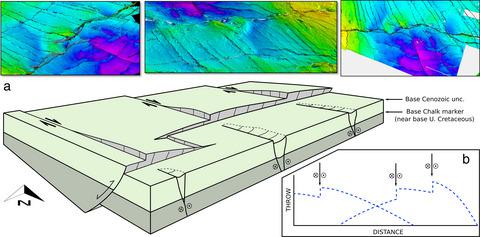当前位置:
X-MOL 学术
›
Basin Res.
›
论文详情
Our official English website, www.x-mol.net, welcomes your
feedback! (Note: you will need to create a separate account there.)
Structural evolution and the partitioning of deformation during basin growth and inversion: a case study from the Mizen Basin Celtic Sea, offshore Ireland
Basin Research ( IF 2.8 ) Pub Date : 2019-09-27 , DOI: 10.1111/bre.12402 Pablo Rodríguez‐Salgado 1, 2 , Conrad Childs 1, 2 , Patrick M. Shannon 1, 3 , John J. Walsh 1, 2
Basin Research ( IF 2.8 ) Pub Date : 2019-09-27 , DOI: 10.1111/bre.12402 Pablo Rodríguez‐Salgado 1, 2 , Conrad Childs 1, 2 , Patrick M. Shannon 1, 3 , John J. Walsh 1, 2
Affiliation

|
[Abstract The Celtic Sea basins lie on the continental shelf between Ireland and northwest France and consist of a series of ENE–WSW trending elongate basins that extend from St George’s Channel Basin in the east to the Fastnet Basin in the west. The basins, which contain Triassic to Neogene stratigraphic sequences, evolved through a complex geological history that includes multiple Mesozoic rift stages and later Cenozoic inversion. The Mizen Basin represents the NW termination of the Celtic Sea basins and consists of two NE–SW‐trending half‐grabens developed as a result of the reactivation of Palaeozoic (Caledonian, Lower Carboniferous and Variscan) faults. The faults bounding the Mizen Basin were active as normal faults from Early Triassic to Late Cretaceous times. Most of the fault displacement took place during Berriasian to Hauterivian (Early Cretaceous) times, with a NW–SE direction of extension. A later phase of Aptian to Cenomanian (Early to Late Cretaceous) N–S‐oriented extension gave rise to E–W‐striking minor normal faults and reactivation of the pre‐existing basin bounding faults that propagated upwards as left‐stepping arrays of segmented normal faults. In common with most of the Celtic Sea basins, the Mizen Basin experienced a period of major erosion, attributed to tectonic uplift, during the Paleocene. Approximately N–S Alpine regional compression‐causing basin inversion is dated as Middle Eocene to Miocene by a well‐preserved syn‐inversion stratigraphy. Reverse reactivation of the basin bounding faults was broadly synchronous with the formation of a set of near‐orthogonal NW–SE dextral strike‐slip faults so that compression was partitioned onto two fault sets, the geometrical configuration of which is partly inherited from Palaeozoic basement structure. The segmented character of the fault forming the southern boundary of the Mizen Basin was preserved during Alpine inversion so that Cenozoic reverse displacement distribution on syn‐inversion horizons mirrors the earlier extensional displacements. Segmentation of normal faults therefore controls the geometry and location of inversion structures, including inversion anticlines and the back rotation of earlier relay ramps., Reverse displacements during inversion mirror normal displacements during extension. Inversion occurred by coeval reverse reactivation of normal faults and dextral strike‐slip faulting. The throw profiles are stepped where they intersect the larger strike‐slip faults increases in throw across the branchpoints with the dextral strike‐slip faults. ]
中文翻译:

盆地生长和反转过程中的构造演化和变形划分:以爱尔兰近海米津盆地凯尔特海为例
[摘要 凯尔特海盆地位于爱尔兰和法国西北部之间的大陆架上,由一系列 ENE-WSW 向细长盆地组成,从东部的圣乔治海峡盆地延伸到西部的法斯特内盆地。这些盆地包含三叠纪至新近纪地层序列,其演化经历了复杂的地质历史,包括多个中生代裂谷阶段和后来的新生代反转。Mizen 盆地代表了凯尔特海盆地的 NW 端,由两个 NE-SW 向的半地堑组成,这些地堑是古生界(加里东、下石炭纪和瓦利斯坎)断层再活化的结果。从早三叠世到晚白垩世,米津盆地边界的断层作为正断层活动。大多数断层位移发生在 Berriasian 到 Hauterivian(早白垩世)时期,具有 NW-SE 延伸方向。Aptian 到 Cenomanian 的后期(早到晚白垩世)N-S 向伸展引起了东西向的小正断层和先前存在的盆地边界断层的重新激活,这些断层向上传播为分段的左步进阵列正常故障。与大多数凯尔特海盆地一样,米津盆地在古新世经历了一段主要的侵蚀,归因于构造抬升。通过保存完好的同向反转地层,大约 N-S 高山区域挤压引起的盆地反转被定为中始新世至中新世。盆地边界断层的逆激活与一组近正交的 NW-SE 右旋走滑断层的形成大致同步,因此压缩被划分为两个断层组,其几何构型部分继承自古生代基底结构. 形成米津盆地南部边界的断层的分段特征在高山反转期间得以保留,因此同步反转层位上的新生代反向位移分布反映了早期的伸展位移。因此,正断层的分段控制着反演结构的几何形状和位置,包括反演背斜和早期中继斜坡的反向旋转。反演期间的反向位移反映了伸展期间的法向位移。反转发生在正断层和右旋走滑断层的同时期反向再激活过程中。在它们与较大的走滑断层相交的地方,断层剖面呈阶梯状,越过右旋走滑断层的分支点,断层增加。]
更新日期:2019-09-27
中文翻译:

盆地生长和反转过程中的构造演化和变形划分:以爱尔兰近海米津盆地凯尔特海为例
[摘要 凯尔特海盆地位于爱尔兰和法国西北部之间的大陆架上,由一系列 ENE-WSW 向细长盆地组成,从东部的圣乔治海峡盆地延伸到西部的法斯特内盆地。这些盆地包含三叠纪至新近纪地层序列,其演化经历了复杂的地质历史,包括多个中生代裂谷阶段和后来的新生代反转。Mizen 盆地代表了凯尔特海盆地的 NW 端,由两个 NE-SW 向的半地堑组成,这些地堑是古生界(加里东、下石炭纪和瓦利斯坎)断层再活化的结果。从早三叠世到晚白垩世,米津盆地边界的断层作为正断层活动。大多数断层位移发生在 Berriasian 到 Hauterivian(早白垩世)时期,具有 NW-SE 延伸方向。Aptian 到 Cenomanian 的后期(早到晚白垩世)N-S 向伸展引起了东西向的小正断层和先前存在的盆地边界断层的重新激活,这些断层向上传播为分段的左步进阵列正常故障。与大多数凯尔特海盆地一样,米津盆地在古新世经历了一段主要的侵蚀,归因于构造抬升。通过保存完好的同向反转地层,大约 N-S 高山区域挤压引起的盆地反转被定为中始新世至中新世。盆地边界断层的逆激活与一组近正交的 NW-SE 右旋走滑断层的形成大致同步,因此压缩被划分为两个断层组,其几何构型部分继承自古生代基底结构. 形成米津盆地南部边界的断层的分段特征在高山反转期间得以保留,因此同步反转层位上的新生代反向位移分布反映了早期的伸展位移。因此,正断层的分段控制着反演结构的几何形状和位置,包括反演背斜和早期中继斜坡的反向旋转。反演期间的反向位移反映了伸展期间的法向位移。反转发生在正断层和右旋走滑断层的同时期反向再激活过程中。在它们与较大的走滑断层相交的地方,断层剖面呈阶梯状,越过右旋走滑断层的分支点,断层增加。]











































 京公网安备 11010802027423号
京公网安备 11010802027423号